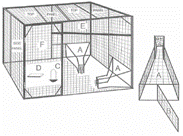Eastern Wildlife Damage Control Conferences
Date of this Version
October 1997
Abstract
The Virginia Cooperative Coyote Control Program was created in 1990 to address increasing livestock losses to coyotes and the inability of producers to solve such problems themselves. The eastern coyote arrived in Virginia in the late 1970s or early 1980s. Lobbying efforts of agricultural groups, such as the Virginia Sheep Federation, helped create a cost-share program administered by the Virginia Department of Agriculture and Consumer Services (VDACS) and U.S. Department of Agriculture-Animal and Plant Health Inspection Service-Wildlife Services (USDA-APHIS-WS). The objective of the program was to educate producers about control methods and to alleviate damage by removing offending coyotes where damage was chronic or economically harmful. The Cooperative Coyote Control Program has focused on educating producers about livestock husbandry practices that reduce coyote predation and developing an integrated direct control program to remove offending coyotes. Initially, only trapping and shooting during daylight hours were legal methods to remove offending coyotes. VDACS and USDA-APHIS-WS worked with the Virginia Department of Game and Inland Fisheries, animal welfare interests, and other affected stakeholders to broaden the methods available to remove coyotes that were killing livestock. In 1997, the integrated coyote control program used traps, shooting, calling and shooting at night, snares, M-44s, denning, and Livestock Protection Collars to remove offending coyotes and stop predation. M-44s and Livestock Protection Collars were restricted to use only by USDA-APHIS-WS personnel. The strategy of alleviating livestock losses in Virginia shifted from primarily corrective control to preventive and corrective control as more effective means to reduce livestock losses. A record-keeping system was implemented to track livestock losses and management responses as means to evaluate the program.


Comments
Published in Proceedings of the Eighth Eastern Wildlife Damage Management Conference, Roanoke, Virginia, October 16–19, 1997, edited by James A. Parkhurst. Copyright © 1997 by the authors.